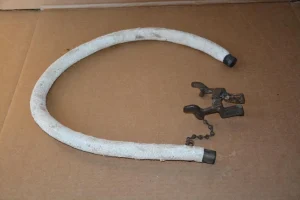Ensuring Linemen’s Safety: The Evolution of Insulated Grounding Clamps
In the realm of electrical tools, few have been as crucial in safeguarding linemen as the insulated grounding clamp. Despite its antique appearance, this tool’s significance lies in its life-saving functionality. Let’s explore its history, operation, and enduring impact on electrical work.

Origins and Functionality
In the early days of electrical engineering, linemen faced perilous tasks in installing and maintaining electrical lines. The insulated grounding clamp emerged as a solution to the grave danger of electrocution, especially with the rapid electrification of cities and towns.
Featuring two metal jaws operated by a spring mechanism, the clamp’s defining feature was its insulated handles. Made from materials like rubber, these handles allowed linemen to work on live wires safely, without direct metal-to-hand contact.

Operation and Safety Measures
The operation of the device was straightforward yet ingenious. Linemen would attach one end of the clamp to a de-energized line and the other to a ground conductor. This ensured that any inadvertent electrical charge would safely dissipate into the earth, sparing the lineman from potential electrocution.
Evolution and Contemporary Variants
Advancements in technology led to the development of more sophisticated grounding clamps that adhere to stringent safety standards. However, these modern variants owe their design and purpose to their antique predecessors, which served as prototypes for refining safety equipment.

From Tools to Collectibles
While no longer in regular use, antique insulated grounding clamps have found a new purpose as collectibles. Enthusiasts and historians seek them not only for their rustic charm but also for the insights they offer into the development of electrical safety practices.
Educational Significance
These vintage tools serve an educational role, showcasing the risks early electrical workers faced and the innovative measures they devised to mitigate those hazards. They are often displayed in museums, trade schools, and by historical societies to educate new generations of electricians about the evolution of their trade.
A Testament to Ingenuity and Safety
The antique lineman’s insulated grounding clamp stands as a testament to human ingenuity and the relentless pursuit of workplace safety. Though now resting in museums or private collections, its impact on the electrical field remains significant. It pays homage to the bravery of those who worked tirelessly to connect our world through electricity, saving countless lives in the process.


